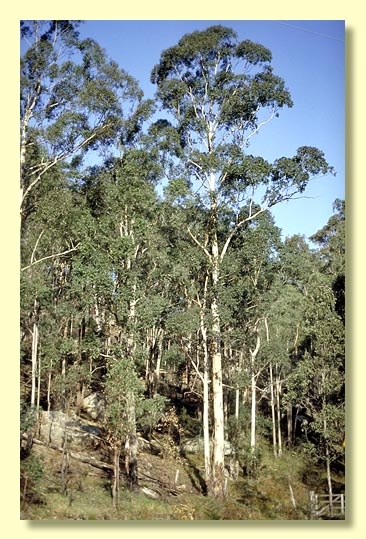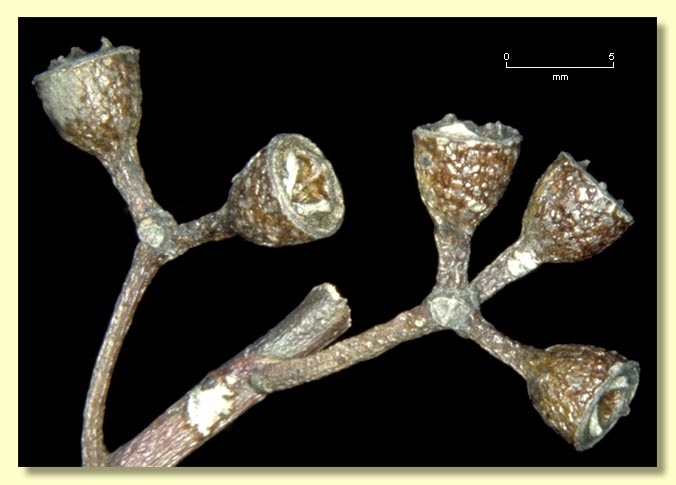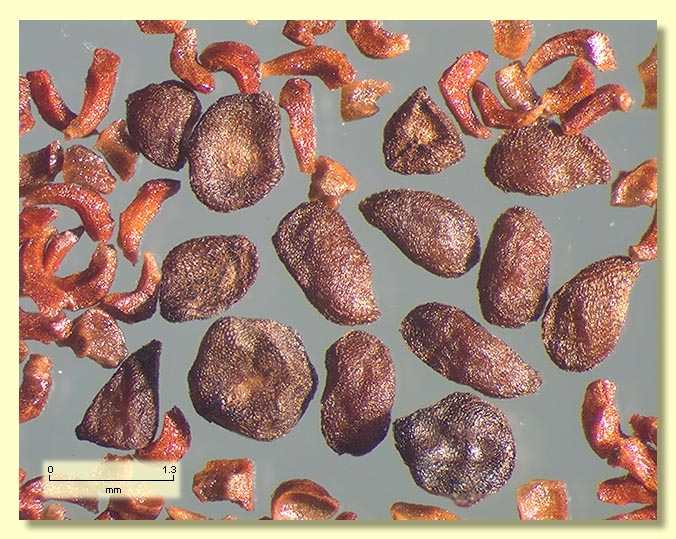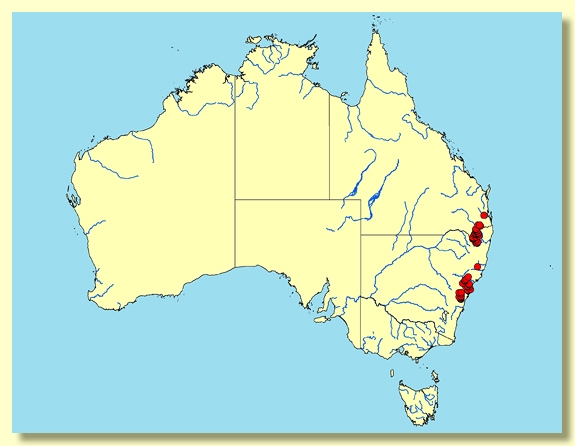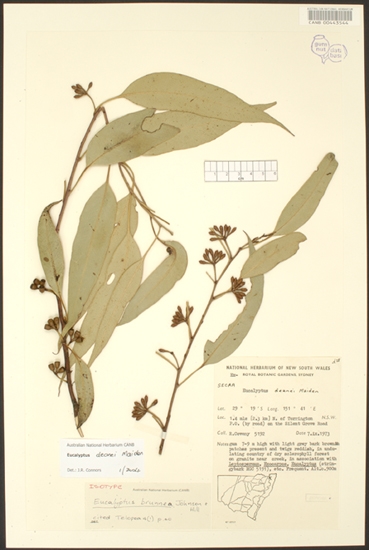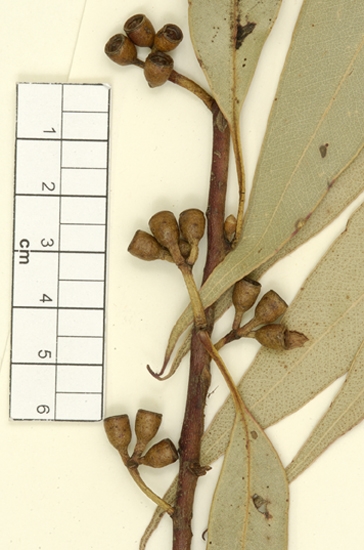Euclid - Online edition
Eucalyptus deanei
Eucalyptus | Symphyomyrtus | Latoangulatae | Transversae
Eucalyptus saligna var. parviflora H.Deane & Maiden, Proc. Linn. Soc. New South Wales 242: 486 (1888).
T: The Valley, Springwood, NSW, Apr. 1888, H.Deane s.n.; lecto: NSW, fide J.H.Maiden, Crit. Revis. Eucalyptus 3: 65 (1915).
Eucalyptus brunnea L.A.S.Johnson & K.D.Hill, Telopea 4: 40 (1990). T: NSW, Northern Tablelands, 2.3 km N of Torrington on Silent Grove road, 7 Sept. 1973, R.Coveny 5192; holo: NSW.
Bark smooth throughout, or sometimes with some persistent scaly grey or grey-brown bark at base of trunk; smooth bark white or cream, with patches of yellow, pink, grey or orange, sometimes powdery.
Juvenile growth (coppice or field seedlings to 50 cm): stem rounded or square in cross-section; juvenile leaves always petiolate, opposite for about 6 nodes then alternate, orbicular to ovate, 4–10.5 cm long, 2.5–6 cm wide, discolorous, glossy, green above. Crown often has many intermediate ovate leaves, as well as adult leaves, creating a general broad-leaved appearance.
Adult leaves alternate, petiole 1.7–4 cm long; blade lanceolate to broadly so, 7–18.5 cm long, 1.5–4 cm wide, flat or slightly undulate, base tapering to petiole, discolorous, glossy, darker green above, paler below, side-veins greater than 45° to midrib, densely to very densely reticulate, intramarginal vein parallel to and just within margin, oil glands mostly island.
Inflorescence axillary unbranched, peduncles 0.8–2.2 cm long, buds 7, 9 or 11 per umbel, pedicellate (pedicels 0.3–0.6 cm long). Mature buds obovoid to pyriform (0.4–0.7 cm long, 0.3–0.4 cm wide), green or reddish, scar present, operculum conical to rounded or beaked, stamens irregularly flexed, anthers cuboid to oblong, versatile, dorsifixed, dehiscing by longitudinal slits (non-confluent), style long, stigma blunt, locules 3 or 4, the placentae each with 4 vertical ovule rows. Flowers white.
Fruit pedicellate (pedicels 0.2–0.8 cm long), cup-shaped to campanulate, 0.4–0.6(0.7) cm long, 0.5–0.7 cm wide, disc level or descending, valves 3 or 4, exserted or near rim level.
Seeds brown or grey, 1–2 mm long, ovoid to cuboid, often pointed at one end, dorsal surface usually pitted, hilum ventral.
Cultivated seedlings (measured at ca node 10): cotyledons bilobed to oblong; stems square in cross-section, rarely glaucous; leaves always petiolate, opposite for 5 or 6 nodes then alternate, ovate, 7.5–10.5 cm long, 3.5–5.5 cm wide, base rounded, truncate or tapering, apex pointed, discolorous, glossy, darker green above.
Flowering has been recorded in February and March.
A medium-sized to tall smooth-barked tree distributed in New South Wales from Picton north to about Singleton and, disjunctly, from south-east of Armidale extending to far south-eastern Queensland between Inglewood and Killarney, in valleys and on slopes in well-watered country on granitic soils. It has the mottled bark of the grey gums and exposes bright yellow unweathered bark when freshly shed. Low branches in the crown, coppice growth and saplings are conspicuous for their roundish glossy green leaves that distinguish E. deanei from the related species E. saligna and E. grandis, which have ovate to lanceolate juvenile leaves. The adult leaves of E. deanei, E. grandis and E. saligna are discolorous, darker green above, paler below, a feature shared with an unrelated group the mahoganies (e.g. E. robusta), which have pyramidal seed with a terminal hilum while those in E. deanei, E. grandis and E. saligna are flattish with a ventral hilum.
Eucalyptus deanei belongs in Eucalyptus subgenus Symphyomyrtus section Latoangulatae because cotyledons are bilobed, leaves are discolorous and have side-veins at a wide angle to the midrib, buds have two opercula and fruit have exserted valves. Within this section, E. deanei is one of three species forming series Transversae because ovules are in four rows, seeds are ovoid to cuboid and bark is smooth. The other two species are E. grandis and E. saligna, which differ as outlined above.
The northern form of E. deanei was described in 1990 as a different species, E. brunnea, but this is included here in E. deanei. The stated differences are slight: more glossy adult and juvenile leaves with distinct brownish markings, seasonally brownish smooth bark, juvenile leaves with rounded rather than pointed apex (drip-tip). (See Johnson & Hill ibid. for discussion of the differences).

